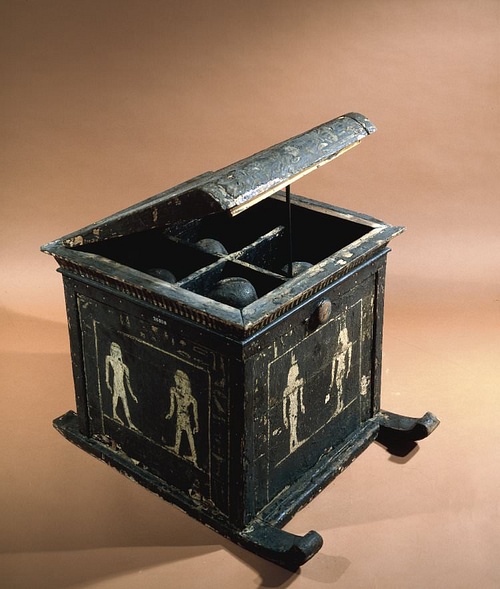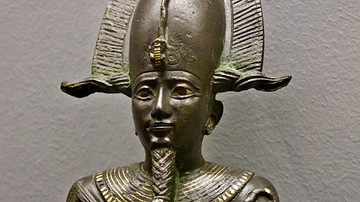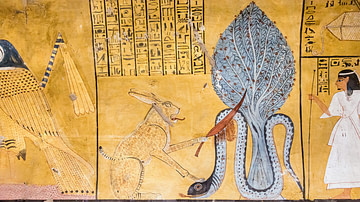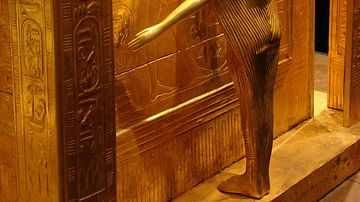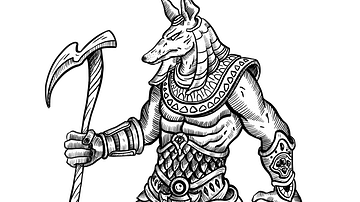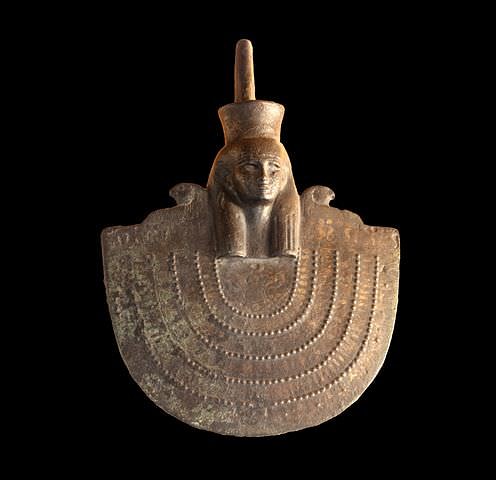
Neith (aka Net, Neit or Nit) and is one of the oldest deities of ancient Egypt who was worshipped early in the Pre-Dynastic Period (c. 6000 - 3150 BCE) and whose veneration continued through the Ptolemaic Dynasty (323 - 30 BCE), the last to rule Egypt before the coming of Rome.
She was a war goddess, goddess of creation, mother goddess who invented birth, and funerary goddess who cared for and helped to dress the souls of the dead. Her cult center was at Sais in the Nile Delta and she continued as the most popular goddess of Lower Egypt even after her attributes were largely given to Isis and Hathor and those goddesses became more popular in Egypt. Neith continued to be honored as the patron goddess of Sais throughout Egypt's history as she was considered a great protector of the people of the land and the most effective mediator between humanity and the gods.
Neith is said to have been present at the creation of the world and, in some stories, even the creator herself who gave birth to Atum (Ra) who then completed the act of creation. She is always represented as extremely wise and just as in the story of The Contendings of Horus and Set where she settles the question of who will rule Egypt and, by extension, the world. She is one of the four goddesses, along with Isis, Nephthys, and Serket, who appear on the canopic jars in the tomb of Tutankhamun and is probably best known today for her statuary there.
She stands watch over Duamutef, one of the Four Sons of Horus, who guards the canopic jars in the tombs and also appears alongside Osiris, Anubis, and Thoth as a just judge of the dead in the afterlife. Her symbols are the bow and arrows and a sword and shield as a war goddess, a weaving shuttle as a funerary goddess, and the Red Crown of Lower Egypt as goddess of creation and mother goddess. Neith is frequently depicted sitting on her throne holding either a sceptre or a bow and two arrows. She is also sometimes seen as a cow, linking her with Hathor or with the Great Cow who was mother to Ra.
Name & Origins
Neith is also known by the names Net, Neit, Nit all of which, according to scholar Geralidne Pinch, may mean "the terrifying one" because of her immense power and wide reach (169). She was also called "mother of the gods", "grandmother of the gods", and "great goddess".
Her worship began in Lower Egypt around the city of Sais and she is thought to have originally been a goddess of hunting. The earliest depictions of her show her with a bow and arrows but, according to Geraldine Pinch, this was a later interpretation of an earlier symbol: "The curious symbol that represented Neith in these early times may originally have been a click beetle. Later this symbol was reinterpreted as two arrows crossing a shield. Click beetles are usually found near water and Neith was often equated with Mehet-Weret, a primeval goddess whose name means the Great Flood" (170).
There is no doubt, however, that she became a war goddess by the time of the Early Dynastic Period (c. 3150-2613 BCE) as names for her from that period include "Neith Fights", "Neith is Victorious" and, by the time of the Old Kingdom (c. 2613-2181 BCE), she was considered a wise veteran and the dependable mediator of the gods and between the gods and humanity. Scholar Richard H. Wilkinson comments on this:
Neith is one of the most ancient deities known from Egypt. There is ample evidence that she was one of the most important deities of the prehistoric and Early Dynastic periods and, impressively, her veneration persisted to the very end of the pharaonic age. Her character was complex as her mythology continued to grow over this great span of time and, although many early myths of the goddess are undoubtebly lost to us, the picture we are able to recover is still one of a powerful deity whose roles encompassed aspects of this life and the beyond. (156-157)
According to one myth, Neith preceeded creation and was present when the waters of Nun began to swirl at her command to give rise to the ben-ben (the primordial mound) upon which Ra (Atum) stood to complete the task. In another version of the story, Neith created the world and then went directly to found her city of Sais, leaving the rest of the work to Atum. By the time of the end of the Ptolemaic Dynasty Neith was still recognized as a creative force of enormous power who "created the world by speaking seven magical words" (Pinch, 170).
She was closely associated with the creative element of water and was "the personification of the fertile primeval waters" and was "the mother of all snakes and crocodiles" as well as being the "great mother who gave birth to Ra and who instituted giving birth when there had been no childbirth before" (Pinch, 170). In still other myths, it is Neith, not Isis, who is the mother of Horus the divine child and restorer of order.
Neith may have originally been a fertility deity corresponding to the goddess Tanit who was later worshipped in North Africa at Carthage in that Ta-Nit in Egyptian means "the land of Nit" and can also be interpreted as "from the land of Nit", as that region was known. She is also associated with Astarte of Phoenicia and, through her, to Ishtar of Mesopotamia. Herodotus claims that the people of Sais were deeply devoted to Neith as the creator and preserver of all and identified her with the Greek goddess Athena.
Plato also comments on the link between Neith and Athena in his dialogue of the Timaeus where he writes, "The citizens [of Sais] have a deity for their foundress; she is called in the Egyptian tongue Neith and is asserted by them to be the same whom the Hellenes call Athena" (21e). Her identification as the most powerful creative force in the universe is noted by Plutarch (c. 50 - 120 CE) who writes that the temple of Neith at Sais held this inscription: "I Am All That Has Been, That Is, and That Will Be. No Mortal Has Yet Been Able to Life the Veil that Covers Me". It is interesting to note that her name, among its many other connotations, links to the root word for "weave" which carries with it the meaning of "to make exist" or "create" or "to be".
Neith the Great Goddess
Egyptian religious life - which was not in any way differentiated from daily life - was centered on the concept of ma'at (harmony and balance) and there are many deities besides the goddess Ma'at who embody and uphold this concept. Thoth, for example, healed and helped both Horus and Set in their struggle for supremacy of rule so that the contest would be balanced.
Neith performed this same function as it is said that her spittle created the serprent monster Apophis who nightly tried to destroy the boat of the sun god and so return the order of the universe to chaos and, at the same time, she was the mother of the sun god and his protector. She is depicted as destroying her child Apophis and, at the same time, creating him as she is also seen as protecting her son Ra while having created his arch enemy; in all of this, balance was achieved.
In the same way, Neith invented birth and gave life to humanity but was also there at a person's death to help them adjust to the new world of the afterlife. She helped to dress the dead and open the way for them to the afterlife and the hope of immortality and paradise in the Field of Reeds. As she was associated with weaving, she became linked to the goddesses Tatet and Nephthys who helped prepare the dead souls to move forward and also with Qebhet who cared for the dead and made sure they had cool water to drink as they awaited judgment.
As with many, if not all, of the Egyptian deities, Neith was a part of a person's life from their birth through their death and on into the afterlife. One was never alone in the universe because the gods were constantly watching and protecting and guiding one on one's path and that path was eternal no matter how temporal it might seem to people on earth.
Worship of the Goddess
Neith was worshipped throughout Egypt but most ardently at Sais and in Lower Egypt. She was a part of the Triad of Latopolis at Esna along with Khnum ("The Great Potter" who fashioned human beings) and Heka (god of magic and medicine) replacing the goddess Menhet who may have actually been only an aspect of Neith. She was also worshipped as the consort of Set, god of chaos, in another example of the importance of balance to the Egyptian religion.
In The Contendings of Horus and Set, Neith tells the gods of the tribunal that Horus should be declared king after his father Osiris' death and resurrection and that Set should rule the wild lands beyond Egypt's border and be given two goddesses, Anat and Astarte, as consorts to keep him company. She was also associated with Osiris and watches over his mummified body to keep it safe from Set so that Isis and Nephthys can revive him. In all these aspects, again, she is seen as keeping balance. Although she may be Set's consort she is also friend to his adversary Osiris and sides with Osiris' son Horus against Set in the interests of justice and harmony. This seems to have been her primary role from very early on in Egypt's history as Wilkinson notes writing on her longevity:
Neith's prominence in early dynastic times - as seen in 1st-dynasty labels, funerary stelae, and in the names of her priestesses and the contemporary queens such as Neithotep and Merneith - suggest the goddess was worshipped from the beginnings of Egyptian culture. In fact, the earliest portrayal of what is thought to be a sacred shrine in Egypt is associated with Neith. (158)
Her association with balance can be seen in some of her iconography where she is pictured with three heads representing three points of view and also as a woman with an erect phallus representing both male and female. In these depictions she is also seen with wings spread wide and arms open in an embrace of all who come to her.
Neith's clergy were female and her temple at Sais, according to Herodotus, was one of the most impressive in all of Egypt. Daily worship of Neith would have been in accordance with the customs concerning all the gods where her statue in the inner sanctum of the temple would have been tended by the High Priestess (who alone could enter the room) and the other chambers taken care of by lesser priestesses. People who came to the temple were allowed only in the outer courtyards where they offered their sacrifices to the goddess with requests for her aid or in thanks for assistance given.
Her annual festival was celebrated on the 13th day of the 3rd month of summer and was known as The Festival of the Lamps. On this day people arrived from all over Egypt to pay their respects to the goddess and offer her gifts. At night they would light lamps which, according to Herodotus, were "saucers full of salt and oil, the wick floating thereon, and burning all night" and even those who did not attend the festival lighted such lamps in their homes, in other temples, and in the palaces so that the whole of Egypt would be illuminated all night long (Histories, II.62). These lamps were thought to mirror the stars in the night sky which were claimed to be either deities or paths to those deities.
At Neith's festival the veil between the earthly realm and the land of the dead was thought to part and people could see and speak with their departed friends and family members. The lights on earth mirroring the stars helped to part this veil because earth and the heavens would appear the same to both the living and the dead. The festival touched upon the Osiris myth and Neith's part in his resurrection as she opened the way for the dead to communicate with the living in the same way she had helped Isis and Nephthys bring Osiris back to life.
Wilkinson notes that "the worship of Neith spanned virtually all of Egypt's history and she remained to the end `Neith the Great'" (159). Although many of her attributes were given to Isis and Hathor, as previously noted, her worship never declined. Even during eras where more popular deities received the greater attention, Neith continued to be regarded with reverence and awe and her festival was considered one of the most important in ancient Egypt.

